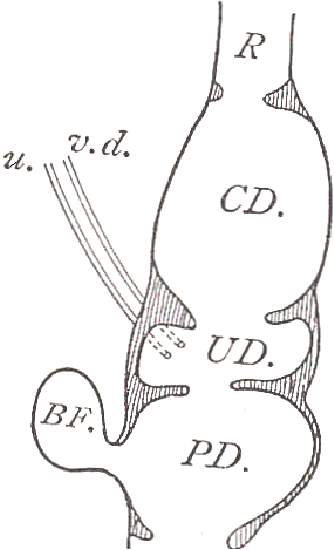
Diagram of the Cloaca of a Bird
BF. ..... Bursa of Fabricius
(Bursa Fabricii) ;
CD. ..... Coprodaeum ;
UD. ..... Urodaeum ;
PD. ..... Proctodaeum
R. ..... Rectum ;
u. ..... Ureter ;
v.d. ..... Vas de ferens
|
The urino-genital chamber or "urodaeum" is small,
and receives in its dorso-lateral walls the ureters and the genital ducts,
which are protected by papillae. Above their orifices is a circular fold,
most prominent on the ventral side; below them, towards the vent, is another
well-marked circular fold, which, towards the ventral aspect, passes into
the coating of the copulatory organ, when such is present. The space between
this fold and the outer anal opening, which is closed by a strong sphincter
muscle, lodges the copulatory organ, and on its dorsal wall leads through
a wide opening into the bursa of Fabricius or bursa Fabricii. This
organ is peculiar to birds, is most developed in the young of both sexes,
and often becomes more or less obliterated in the adult. Its function
is to produce "B cells" (which are normally produced in the bone marrow
in mammals).
The innermost chamber, or "coprodaeum," is situated
above the urodaeum, is mostly an oval dilatation of the rectum, and is
of considerable size in those birds whose faeces are very fluid, as Accipitres,
Herodii, and Steganopodes. In the Cassowary
and Rhea it passes gradually into the rectum above, but in many Carinatae,
as well as in Struthio, the upper end is marked by a strong circular fold,
and the inner surface of the walls is smooth and different from that of
the rectum proper. In Struthio this chamber is followed by another, which
is smaller and less defined, resembling in this respect some Saurians.
It follows from the arrangement described above,
that in Birds the urine is not retained in the small urodaeum, but that,
as in Saurians, it passes into the next chamber above. Through this the
faeces pass; if they are very fluid, they collect in the then very capacious
space, together with the urine, and transform the chamber into a physiological
cloaca. If the faeces are more solid, as for instance in Geese, they
are retained in the rectum proper, and simply pass through the cloaca.
In the Ostriches defaecation and micturition are mostly separate acts,
especially when the largely-developed and persistent bursa of Fabricius
acts as a physiological bladder. A true urinary bladder, i.e.
a ventral dilatation of the urodaeum, is absent in Birds.
The copulatory organ in the male, and the corresponding
part in the female, are developed from the ventral wall of the vestibulum
or "proctodaeum." It is present in two different forms.
|





